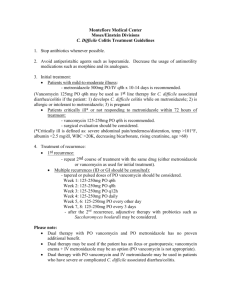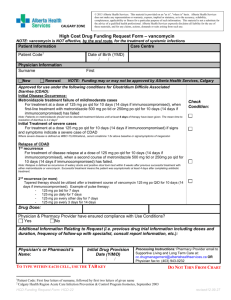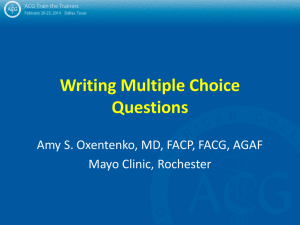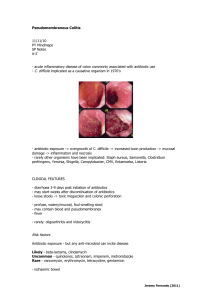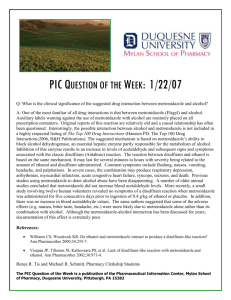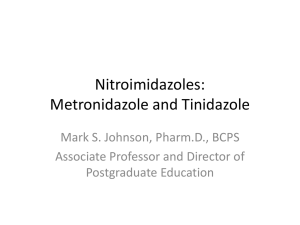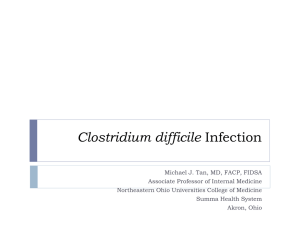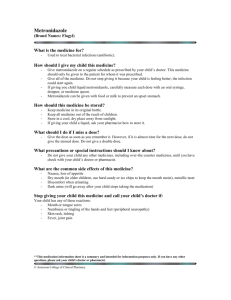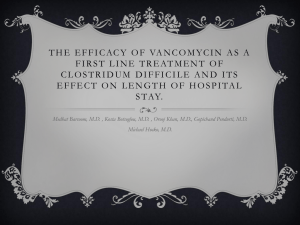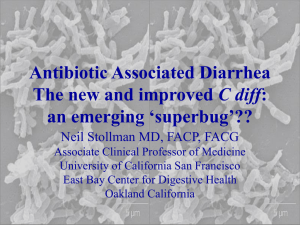CLOSTRIDIUM DIFFICILE PATHWAY
advertisement
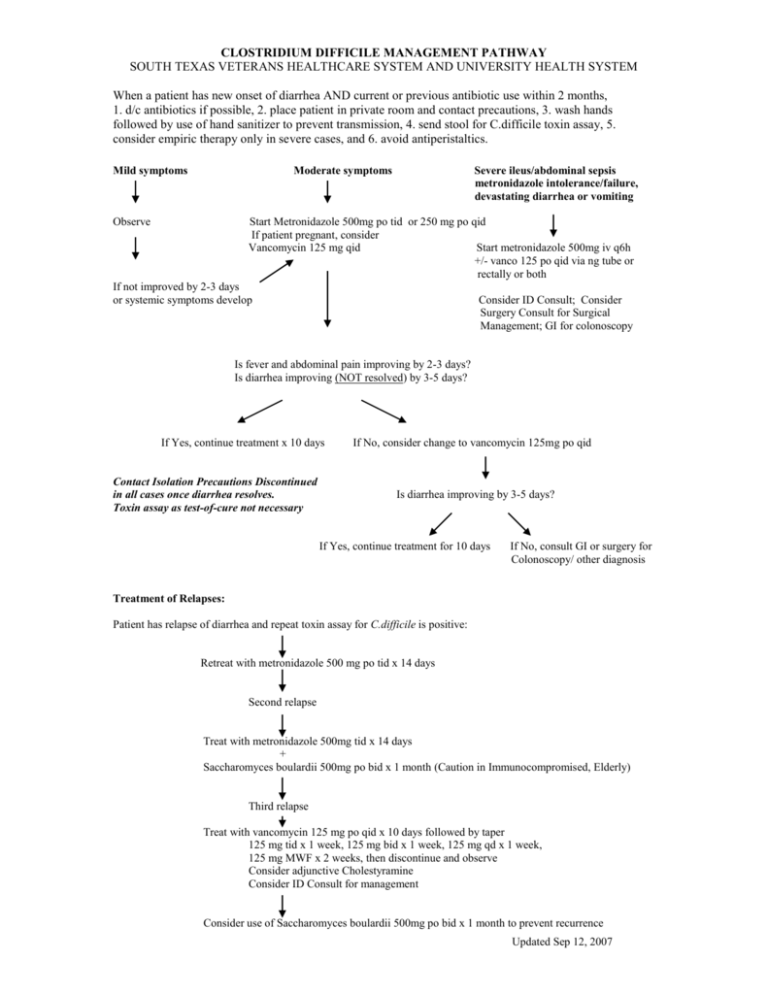
CLOSTRIDIUM DIFFICILE MANAGEMENT PATHWAY SOUTH TEXAS VETERANS HEALTHCARE SYSTEM AND UNIVERSITY HEALTH SYSTEM When a patient has new onset of diarrhea AND current or previous antibiotic use within 2 months, 1. d/c antibiotics if possible, 2. place patient in private room and contact precautions, 3. wash hands followed by use of hand sanitizer to prevent transmission, 4. send stool for C.difficile toxin assay, 5. consider empiric therapy only in severe cases, and 6. avoid antiperistaltics. Mild symptoms Moderate symptoms Observe Severe ileus/abdominal sepsis metronidazole intolerance/failure, devastating diarrhea or vomiting Start Metronidazole 500mg po tid or 250 mg po qid If patient pregnant, consider Vancomycin 125 mg qid Start metronidazole 500mg iv q6h +/- vanco 125 po qid via ng tube or rectally or both If not improved by 2-3 days or systemic symptoms develop Consider ID Consult; Consider Surgery Consult for Surgical Management; GI for colonoscopy Is fever and abdominal pain improving by 2-3 days? Is diarrhea improving (NOT resolved) by 3-5 days? If Yes, continue treatment x 10 days Contact Isolation Precautions Discontinued in all cases once diarrhea resolves. Toxin assay as test-of-cure not necessary If No, consider change to vancomycin 125mg po qid Is diarrhea improving by 3-5 days? If Yes, continue treatment for 10 days If No, consult GI or surgery for Colonoscopy/ other diagnosis Treatment of Relapses: Patient has relapse of diarrhea and repeat toxin assay for C.difficile is positive: Retreat with metronidazole 500 mg po tid x 14 days Second relapse Treat with metronidazole 500mg tid x 14 days + Saccharomyces boulardii 500mg po bid x 1 month (Caution in Immunocompromised, Elderly) Third relapse Treat with vancomycin 125 mg po qid x 10 days followed by taper 125 mg tid x 1 week, 125 mg bid x 1 week, 125 mg qd x 1 week, 125 mg MWF x 2 weeks, then discontinue and observe Consider adjunctive Cholestyramine Consider ID Consult for management Consider use of Saccharomyces boulardii 500mg po bid x 1 month to prevent recurrence Updated Sep 12, 2007 INFORMATION ON CLOSTRIDIUM DIFFICILE Clinical Relevance: Anaerobic gram-positive spore-forming bacillus Colonizes colon in 3% healthy adults and 10-30% hospitalized pts C. difficile causes 20% of antibiotic associated diarrheas & >95% of pseudomembranous colitis Risk factors: Antibiotic Use (especially clindamycin, cephalosporins, quinolones), Proton Pump Inhibitors, Increased Age, Hospitalization, Multiple Co-morbidities, Enteral feedings Clinical Manifestations: diarrhea, fever, cramps, high WBC; in severe cases, WBC >25-30k, abdominal distension, constipation, ileus, vomiting, sepsis. Colonic manifestations are colitis/pseudomembranous colitis, toxic megacolon; Extra-colonic manifestations rare – few reported cases of enteritis, reactive arthritis Tests: At our facilities, EIA for toxin A + B is done (falsely negative in 20-30%). Therefore, sending up to 3 specimens improves diagnostic yield. Culture not done for diagnostic purposes. Do not send test of cure after diarrhea resolves. Do not order routine stool cultures or O&P in patients who have been in the hospital > 72 hrs (extremely low yield!) unless immunosuppressed Fever and abdominal pain usually improves in 2-3 days and diarrhea in 3-5 days. Do not consider treatment failure unless the diarrhea is not improving in 5 days. If diarrhea persists >5-7d, question diagnosis or consider concurrent IBD, lactase deficiency, etc. 5-50% of patients will relapse after a successful course of therapy. Re-treatment with metronidazole will nearly always be successful. 25-30% of these patients will have multiple recurrences (up to 10) regardless of choice of therapy. Re-treatment with antibiotics in the weeks to months after a C.diff episode GREATLY increases the risk of relapse – AVOID antibiotics if possible Treatment: Principles: + toxin assay, d/c implicated abx, avoid antiperistaltics, infection control (contact isolation) +/- metronidazole Antibiotic guidelines: IDSA, CDC, SHEA - all say metronidazole is preferred treatment. >90% patients will respond to either metronidazole or vancomycin as initial therapy – vancomycin is considerably more expensive than metronidazole ($16-68/day vs $0.12/day) and may predispose to colonization with vancomycin resistant enterococcus Seriously ill or metronidazole failure: vancomycin 125-500 mg PO (or J-tube, or rectally) qid. IV vancomycin will be reconstituted and given orally for inpatients Toxin assay negative and high probability: repeat test + treat empirically Supportive care: IV hydration or oral fluids Avoid antiperistaltics (Lomotil, loperamide, opiates) Infection control: private room, contact precautions, wash hands (alcohol-based hand rub does not kill spores reliably) If need systemic abx for ongoing infection (other than C. difficile): use oral metronidazole + agent unlikely to cause C. difficile: IV vancomycin, macrolide, sulfa, doxycycline or aminoglycoside Ileus or vomiting: IV Metronidazole 500mg q6h +/- Vancomycin PO (500mg qid) by NG/ jejunal tube or rectal tube or both Surgery: total colectomy if severely ill & unresponsive to PO vanco +/- IV metro, especially if toxic megacolon Treatment of Multiple Relapses: (ID consult or antibiotic management approval required) Metronidazole 250mg PO qid or Vancomycin 125mg PO qid x 10d, and one of the following: Vancomycin 125mg PO qod (pulse dosing) x 6wks Saccharomyces boulardii 500mg PO bid (non-formulary at VA & UHS) from day 6 of vanco x 4-6 wks (caution in elderly and immunocompromised due to rare occurrences of fungemia) Vancomycin + Rifaximin (non-formulary at VA & UHS) Lactobacillus GG 1 tab "Culturelle" (non-formulary at VA & UHS)PO bid + cholestyramine 4gm PO tid x 4-6wks (data not so great) Alt: IVIG 400mg/kg q 3 wks (experimental; availability limited) or vaccine trial Alt: stool from healthy donor via enema or NG tube Updated Sep 12, 2007
